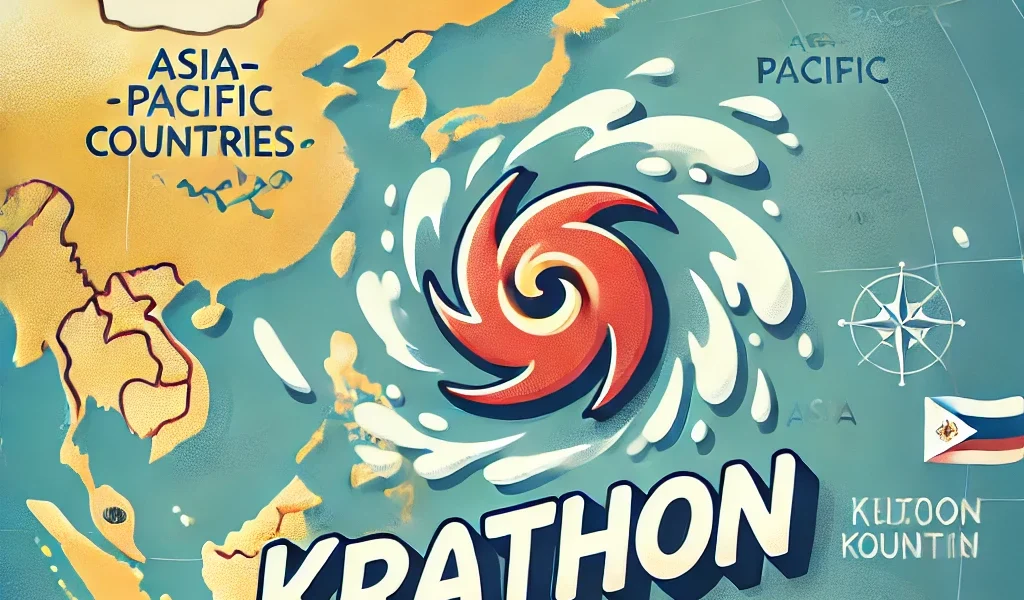Introduction:
Have you ever wondered how typhoons get their names? As Typhoon No. 18, known as “Krathon,” makes its way across the region, it’s the perfect opportunity to explore the intriguing process behind naming these powerful storms. From contributions by different countries to the cultural significance behind each name, let’s discover how typhoons like Krathon receive their unique identities and what makes this particular name so special.

The Origins of Typhoon Naming:
The practice of naming typhoons began to simplify communication and make it easier for people to follow weather reports. Before the modern naming system, typhoons were identified by numbers, which often caused confusion, especially when multiple storms were active simultaneously. To address this issue, the World Meteorological Organization (WMO) and the Typhoon Committee introduced an official naming system in the early 2000s, which brought more clarity and efficiency to weather reporting.
Who Decides Typhoon Names?
The typhoon names used in the Western Pacific and South China Sea regions are determined by the Typhoon Committee, an organization consisting of 14 member countries and regions. These members include South Korea, Japan, China, the Philippines, Thailand, and others. Each member country submits a list of names, which are then compiled into a rotating list used to name typhoons. This collaborative approach ensures that each typhoon name reflects the diverse cultures and languages of the Asia-Pacific region.
Why Is It Called “Krathon”?
The name “Krathon” was submitted by Thailand and refers to the fruit Sandoricum koetjape, commonly known as “Santol” or “mango steen.” This tropical fruit is widely found in Southeast Asia and is often used in Thai cuisine and traditional medicine. When Typhoon No. 18 formed, it was assigned the next available name on the list, which happened to be “Krathon,” giving the storm its unique identity.
The Typhoon Naming Process:
The Typhoon Committee maintains a master list of 140 names contributed by member countries, and these names are used sequentially as typhoons form. Each time a typhoon develops, the next name on the list is assigned to it, and once a name is used, it moves to the back of the list to be reused in future seasons. This system ensures that each typhoon has a distinct name, helping avoid confusion, especially during periods when multiple storms are active.
What Happens When a Name Is Retired?
In some cases, a typhoon’s name may be retired if it was associated with a particularly devastating or deadly storm. Retiring the name serves as a mark of respect for the communities affected by the disaster and prevents future storms from being linked to such a tragic event. For example, names like “Haiyan,” which was the name of the catastrophic typhoon that struck the Philippines in 2013, have been permanently removed from the list. When this happens, the country that originally submitted the retired name provides a new name to replace it.
Cultural Significance of Typhoon Names
One of the most fascinating aspects of the typhoon naming process is the cultural significance behind each name. Since countries in the Asia-Pacific region submit their own names, the list reflects a diverse range of languages, traditions, and natural elements. For example:
- Japan often submits names based on nature, such as “Kajiki” (swordfish) or “Tokage” (lizard).
- The Philippines may use common Filipino names like “Juan” or “Rosita.”
- South Korea has contributed names like “Nari,” meaning lily, and “Goni,” referring to a type of bird.
These culturally rich names make each typhoon more than just a weather event; they transform it into a representation of the region’s diverse heritage.
Why Naming Typhoons Is Important
The process of naming typhoons serves several essential purposes:
- Improved Communication: Giving typhoons unique names makes it easier for the public, media, and government agencies to communicate important information about the storm, ensuring that safety messages reach as many people as possible.
- Clear Identification: When multiple typhoons occur simultaneously, names help differentiate them, reducing confusion and enabling more accurate tracking.
- Cultural Representation: The use of names from different countries fosters a sense of unity and appreciation for the diverse cultures within the Asia-Pacific region.
Learning from Typhoon Krathon
Typhoon Krathon offers a great example of how the typhoon naming system works in practice. As a name contributed by Thailand, it reflects the country’s culture and showcases how even a natural phenomenon like a typhoon can carry a touch of regional identity. Knowing that “Krathon” refers to a tropical fruit helps personalize the storm, making it more relatable and easier to remember.
Conclusion: More Than Just a Name
The naming of typhoons is a fascinating blend of science, culture, and international cooperation. Each name carries its own story and reflects the shared experiences of countries in the Asia-Pacific region. So, the next time you hear about a typhoon like Krathon, remember that there’s more to its name than just letters – it’s a symbol of the cultures and traditions that shape our world.











